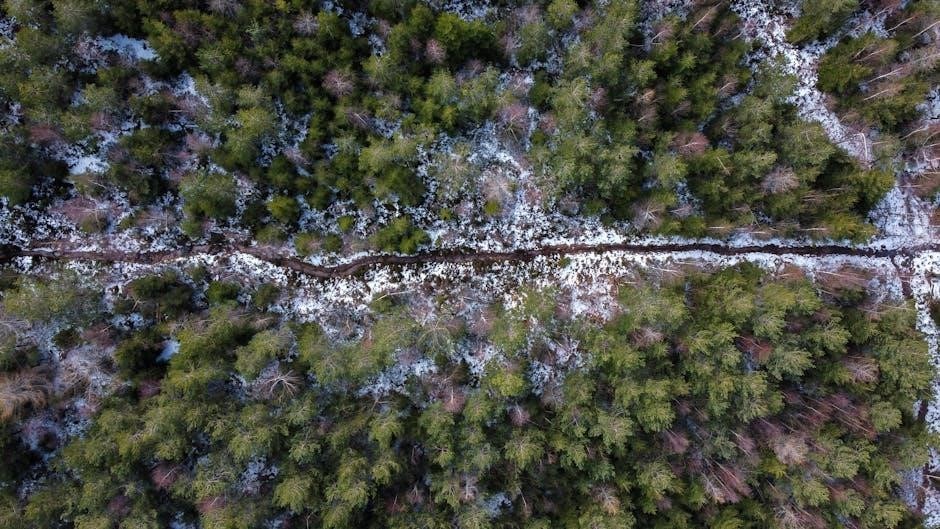The Trail Guide to the Body by Andrew Biel is a comprehensive, hands-on guide for locating muscles, bones, and other musculoskeletal structures. Perfect for anatomy students and professionals, it offers a detailed, step-by-step approach to understanding human anatomy through palpation and movement analysis. Available in both print and PDF formats, it includes a digital workbook and flashcards for enhanced learning. This sixth edition is widely regarded as an essential resource for anyone studying or working in anatomy, physical therapy, or bodywork.
Overview of the Book
The Trail Guide to the Body by Andrew Biel is a detailed, hands-on guide for identifying and understanding musculoskeletal structures. It focuses on muscles, bones, and palpation techniques, making it an essential tool for anatomy students, physical therapists, and bodyworkers. The book is structured to guide learners through a step-by-step exploration of the body, emphasizing practical applications. Available in both print and PDF formats, it includes a spiral-bound design for easy reference. The sixth edition is renowned for its clear illustrations and comprehensive approach, offering a thorough understanding of human anatomy.
Importance of the Guide for Anatomy Students
The Trail Guide to the Body is an indispensable resource for anatomy students, offering a hands-on approach to identifying musculoskeletal structures. Its detailed, step-by-step guidance helps students develop palpation skills, essential for understanding human anatomy. The guide’s practical focus complements classroom learning, making complex anatomical concepts accessible. Available in PDF format, it provides flexibility for study on-the-go. The workbook and flashcards further enhance retention of key concepts. This comprehensive tool is vital for students seeking to master anatomy, whether for academic success or professional applications in fields like physical therapy or bodywork.
Key Features of the Trail Guide to the Body
The Trail Guide to the Body is renowned for its hands-on approach to anatomy, offering detailed step-by-step trails through musculoskeletal structures. It includes over 1,000 illustrations and a spiral-bound design for easy reference. The guide covers key regions like the neck, shoulders, and pelvis, providing clear instructions for palpation. Available in PDF format, it ensures accessibility for digital learners. The sixth edition also includes a digital workbook and flashcards, reinforcing knowledge retention. These features make it a comprehensive tool for anatomy students and professionals, enhancing both practical and theoretical understanding of human anatomy.

The Author and His Expertise

Andrew Biel, a renowned anatomy expert, specializes in palpation techniques and hands-on learning. His work provides practical insights for anatomy students and professionals, enhancing understanding through detailed guidance.
Andrew Biel’s Background in Anatomy
Andrew Biel is a highly respected expert in human anatomy, specializing in palpation and hands-on learning techniques. His extensive experience in teaching anatomy has equipped him with unique insights into the musculoskeletal system. Biel’s work focuses on making complex anatomical concepts accessible through practical, step-by-step guidance. He has developed a range of educational resources, including workbooks and flashcards, to support learners. His expertise has made him a trusted name in the field of anatomy, particularly among students and professionals seeking a deeper understanding of the human body.
His Approach to Teaching Anatomy

Andrew Biel’s approach to teaching anatomy is centered on hands-on learning and practical application. He emphasizes the importance of palpation and movement analysis to understand musculoskeletal structures. Biel’s method encourages students to engage with anatomy through touch and observation, rather than relying solely on textbooks. His step-by-step guidance helps learners identify muscles, bones, and tendons with precision. This interactive approach makes complex anatomical concepts accessible and memorable. By focusing on real-world applications, Biel’s teaching method bridges the gap between theoretical knowledge and practical skills, making it invaluable for anatomy students and professionals alike.

Structure and Content of the Guide
The Trail Guide to the Body offers a step-by-step exploration of musculoskeletal structures, covering key regions and including practical tools like a workbook and flashcards for enhanced learning.
Hands-On Approach to Learning Anatomy
The Trail Guide to the Body emphasizes a hands-on approach, encouraging students to engage with anatomy through palpation and resisted movements. By using touch to identify muscles, bones, and tendons, learners develop a deeper understanding of anatomical structures. The guide provides clear, step-by-step instructions for locating each muscle, making it easier to visualize and remember complex details. This interactive method, combined with practical exercises, helps students apply theoretical knowledge in real-world scenarios, enhancing their retention and mastery of human anatomy. The approach is particularly beneficial for those in physical therapy, bodywork, or medical fields.
Step-by-Step Trail Through Musculoskeletal Structures
The Trail Guide to the Body offers a systematic, step-by-step exploration of musculoskeletal structures, guiding learners through each region of the body. From the pectoral to the cubital areas, the guide provides detailed instructions for identifying muscles, bones, and tendons. Its structured approach ensures a comprehensive understanding of anatomy, allowing students to progress logically from one area to the next. The text includes clear descriptions of palpation techniques and resisted movements, enabling learners to apply practical skills in real-world settings. This methodical journey through the body’s structures enhances retention and mastery of complex anatomical concepts.
Regions of the Body Covered in the Guide
The Trail Guide to the Body meticulously covers key regions, including the pectoral, axillary, brachial, and cubital areas. Each section provides detailed insights into muscles, bones, and tendons, ensuring a thorough understanding of anatomy. The guide emphasizes palpation techniques and resisted movements to help identify structures effectively. Its comprehensive coverage makes it an invaluable resource for anatomy students and professionals, offering practical knowledge that enhances both learning and retention. This systematic approach ensures that all major body regions are explored in depth, making it a complete reference for anyone studying or working in anatomy or related fields.

Resources and Supplements
The Trail Guide to the Body offers a Student Workbook and Flashcards for reinforcing knowledge. Digital versions and PDFs enhance accessibility, providing versatile learning tools for anatomy students.
Trail Guide to the Body Student Workbook
The Trail Guide to the Body Student Workbook is a valuable companion to the main text, offering hands-on exercises and quizzes to reinforce anatomical knowledge. Designed for active learning, it provides space for notes and self-testing, helping students master muscle identification and palpation techniques. Available as a digital download, the workbook complements the PDF version of the guide, making it easy to study on-the-go. Its structured format ensures a deeper understanding of musculoskeletal structures, catering to both students and professionals seeking to enhance their practical skills in anatomy and bodywork.
Flashcards for Reinforcing Knowledge
The Trail Guide to the Body flashcards are an excellent tool for reinforcing anatomical knowledge, particularly for identifying muscles, bones, and joints. Volume 1 focuses on the skeletal system, providing clear, concise information to aid memorization. These flashcards complement the workbook and guide, offering a portable and interactive way to study. Available in digital formats, they can be easily accessed on devices, making them ideal for on-the-go learning. By using these flashcards, students and professionals can quickly review and retain key anatomical details, enhancing their understanding of musculoskeletal structures and their locations.
Digital Versions and Accessibility
The Trail Guide to the Body is available in digital formats, including PDF, offering unparalleled convenience for students and professionals. The digital edition can be easily accessed on laptops, tablets, and smartphones, making it a versatile tool for on-the-go learning. Additionally, the guide is compatible with various platforms, ensuring accessibility across different devices. The PDF version retains the book’s detailed illustrations and step-by-step instructions, while digital features like search functions enhance navigation. This accessibility makes the guide an indispensable resource for anatomy enthusiasts, allowing them to study anywhere and at any time.

Palpation Techniques and Practices
The guide emphasizes hands-on palpation techniques, using resisted movements to identify muscles and tendons. Practical applications of palpation are explored, enhancing anatomical understanding through tactile exploration and movement analysis.
Using Resisted Movements for Muscle Identification
The Trail Guide to the Body employs resisted movements as a key technique for muscle identification. By applying resistance, individuals can better distinguish the lengths, shapes, and edges of muscles and tendons. This method enhances tactile awareness, allowing learners to pinpoint specific anatomical structures more accurately. The guide provides clear instructions on how to perform these movements effectively, making it an invaluable tool for anatomy students and professionals. Regular practice with resisted movements improves muscle identification skills, deepening one’s understanding of human anatomy and its practical applications in fields like physical therapy and bodywork.
Practical Applications of Palpation
Palpation is a cornerstone technique in the Trail Guide to the Body, offering practical applications in anatomy education and clinical practice. By applying gentle pressure, students and professionals can identify muscles, bones, and tendons with precision. This skill is invaluable in physical therapy, massage, and bodywork, enabling practitioners to assess injuries and plan treatments effectively. Palpation also enhances understanding of musculoskeletal structures, aiding in the identification of muscle imbalances and monitoring progress during rehabilitation. The guide provides detailed instructions on palpation techniques, making it an essential resource for both learners and professionals seeking to refine their anatomical knowledge and diagnostic skills.

Digital Edition and PDF Availability
The Trail Guide to the Body is available in a convenient PDF format, offering easy access to its comprehensive anatomical content. The digital edition ensures portability and accessibility, allowing learners to study on various devices. Supplementary resources, such as the Student Workbook and flashcards, further enhance the learning experience. This format is ideal for anatomy students and professionals seeking a flexible and efficient way to master musculoskeletal anatomy.
How to Download the Trail Guide to the Body PDF
The Trail Guide to the Body PDF can be downloaded from various online platforms, including official bookstores and educational websites. Visit reputable sources like eBooks.com or VitalSource to purchase and download the digital version. Ensure you select the correct edition, such as the 6th edition, to access the most updated content. Once purchased, the PDF can be easily accessed on your device, offering flexibility for study. Additionally, some websites may offer free previews or samples to review before purchasing.
Benefits of the Digital Format
The digital format of the Trail Guide to the Body offers unparalleled convenience and accessibility. Students can easily carry the PDF on tablets, laptops, or smartphones, eliminating the need for physical storage. The digital version is searchable, allowing quick navigation to specific topics or anatomical structures. Highlighting and annotating key points is straightforward, aiding in effective study sessions. Additionally, the PDF format ensures that the guide is always up-to-date, with access to supplementary materials like the workbook and flashcards. This makes it an indispensable tool for anatomy students seeking a flexible and efficient learning experience.

How to Use the Guide Effectively
Use the Trail Guide to the Body by integrating its hands-on approach into your study routine. Follow the step-by-step trails for muscles and bones, and apply palpation techniques for practical learning. Pair the guide with the workbook and flashcards for enhanced retention and understanding of anatomical structures.
Study Tips for Maximizing Learning
To maximize learning with the Trail Guide to the Body, use its hands-on approach by practicing palpation techniques and resistive movements to identify muscles and bones. Follow the step-by-step trails to systematically explore musculoskeletal structures. Pair the guide with the workbook and flashcards for reinforced knowledge retention. Dedicate time to active learning by applying the guide’s methods during anatomy labs or self-study. Regularly review and test yourself using the flashcards to strengthen memory; Integrate digital tools, such as the PDF version, for easy access and portability. Consistency and practical application are key to mastering the material effectively.
Integrating the Guide into Anatomy Courses
The Trail Guide to the Body seamlessly integrates into anatomy courses, offering a practical, hands-on approach to learning. Instructors can incorporate the guide’s step-by-step trails to teach musculoskeletal anatomy through palpation and movement analysis. The workbook provides structured exercises for homework or in-class activities, while flashcards reinforce key concepts. Digital versions enable easy distribution and accessibility for students. Pairing the guide with course materials enhances engagement and understanding. Its clear instructions and visual aids make it an invaluable resource for both classroom and lab settings, fostering a deeper connection between theoretical knowledge and practical application.

Trail Guide to the Body and Body Recomposition
The Trail Guide to the Body aids in understanding muscle and fat distribution, crucial for body recomposition. Its detailed anatomical insights help professionals and individuals achieve balanced body restructuring effectively.
Understanding Muscle and Fat Distribution
The Trail Guide to the Body provides a detailed understanding of muscle and fat distribution, essential for body recomposition. It outlines how muscles and fat layers are structured, enabling precise targeting during exercise and nutrition planning. By mapping these areas, the guide helps professionals and individuals optimize muscle growth while reducing fat, ensuring a balanced approach to body transformation. This anatomical clarity is vital for achieving aesthetic and functional goals, making it a cornerstone resource for those focused on recomposition and physique enhancement.
Practical Insights for Body Recomposition
The Trail Guide to the Body offers practical insights for body recomposition by detailing muscle and fat distribution. It helps professionals and individuals understand how to target specific areas for muscle growth and fat reduction. By identifying key anatomical landmarks, the guide supports effective workout and nutrition strategies. Its step-by-step approach aligns with recomposition goals, ensuring balanced progress. The guide’s focus on palpation and movement analysis further enhances its utility for those aiming to transform their physique, making it a valuable tool for achieving both aesthetic and functional objectives in body recomposition.
The Trail Guide to the Body is a comprehensive, hands-on learning companion, available in PDF. It includes a student workbook and flashcards, making it an essential resource for anatomy students and professionals alike.
Final Thoughts on the Trail Guide to the Body
The Trail Guide to the Body stands out as a comprehensive, hands-on resource for anatomy students and professionals. Its detailed approach to locating muscles, bones, and musculoskeletal structures makes it invaluable for both learning and practice. Available in PDF format, it offers flexibility and accessibility, ensuring that users can study anywhere. The inclusion of a digital workbook and flashcards further enhances its utility, providing a well-rounded learning experience. This guide is not only a practical tool but also a testament to Andrew Biel’s expertise in making anatomy accessible. It remains a top choice for anyone seeking a deeper understanding of the human body.
Recommendations for Further Study
For deeper exploration, the Trail Guide to the Body Student Workbook and flashcards are excellent companions. These resources reinforce knowledge through interactive exercises and self-testing. Additionally, exploring digital anatomy tools can enhance understanding. Cadaver labs and hands-on workshops offer practical experience, while advanced anatomy courses provide specialized insights. For professionals, integrating this guide into clinical practice can refine palpation skills. Supplementary reading on body recomposition and movement analysis further enriches understanding. These tools collectively support a comprehensive and applied grasp of human anatomy, making the Trail Guide a cornerstone of both education and professional development.
